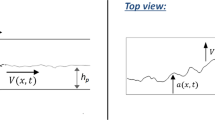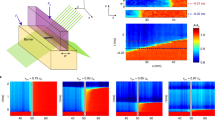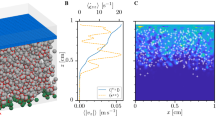Abstract
Inhomogeneous materials, such as plaster or concrete, subjected to an external elastic stress display sudden movements owing to the formation and propagation of microfractures. Studies of acoustic emission from these systems reveal power-law behaviour1. Similar behaviour in damage propagation has also been seen in acoustic emission resulting from volcanic activity2 and hydrogen precipitation in niobium3. It has been suggested that the underlying fracture dynamics in these systems might display self-organized criticality4, implying that long-ranged correlations between fracture events lead to a scale-free cascade of ‘avalanches’. A hierarchy of avalanche events is also observed in a wide range of other systems, such as the dynamics of random magnets5 and high-temperature superconductors6 in magnetic fields, lung inflation7 and seismic behaviour characterized by the Gutenberg–Richter law8. The applicability of self-organized criticality to microfracturing has been questioned9,10, however, as power laws alone are not unequivocal evidence for it. Here we present a scalar model of microfracturing which generates power-law behaviour in properties related to acoustic emission, and a scale-free hierarchy of avalanches characteristic of self-organized criticality. The geometric structure of the fracture surfaces agrees with that seen experimentally. We find that the critical steady state exhibits plastic macroscopic behaviour, which is commonly observed in real materials.
This is a preview of subscription content, access via your institution
Access options
Subscribe to this journal
Receive 51 print issues and online access
$199.00 per year
only $3.90 per issue
Buy this article
- Purchase on Springer Link
- Instant access to full article PDF
Prices may be subject to local taxes which are calculated during checkout





Similar content being viewed by others
References
Petri, A., Paparo, G., Vespignani, A., Alippi, A. & Costantini, M. Experimental evidence for critical dynamics in microfracturing processes. Phys. Rev. Lett. 73, 3423–3426 (1994).
Diodati, P., Marchesoni, F. & Piazza, S. Acoustic emission from volcanic rocks: an example of self-organized criticality. Phys. Rev. Lett. 67, 2239–2242 (1991).
Cannelli, G., Cantelli, R. & Cordero, F. Self-organized criticality of the fracture processes associated with hydrogen precipitation in niobium by acoustic emission. Phys. Rev. Lett. 70, 3923–3926 (1993).
Bak, P., Tang, C. & Wiesenfeld, K. Self-organized criticality: an explanation of 1/f noise. Phys. Rev. Lett. 59, 381–384 (1987).
Cote, P. J. & Meisel, L. V. Self-organized criticality and the Barkhausen effect. Phys. Rev. Lett. 67, 1334–1337 (1991).
Field, S., Witt, J., Nori, F. & Ling, X. Superconducting vortex avalanches. Phys. Rev. Lett. 74, 1206–1209 (1995).
Suki, B., Barabási, A. -L., Hantos, Z., Peták, F. & Stanley, H. E. Avalanches and power-law behaviour in lung inflation. Nature 368, 615–618 (1994).
Gutenberg, B. & Richter, C. F. Frequency of earthquakes in California. Bull. Seismol. Soc. Am. 34, 185–188 (1944).
Sornette, D. Power laws without parameter tuning: an alternative to self-organized criticality. Phys. Rev. Lett. 72, 2306 (1994).
Cannelli, G., Cantelli, R. & Cordero, F. Reply to Sornette D., ‘Power laws without parameter tuning: an alternative to self-organized criticality’. Phys. Rev. Lett. 72, 2307 (1994).
Herrmann, H. J. & Roux, S. (eds) Statistical Models for the Fracture of Disordered Media (North Holland, Amsterdam, 1990).
Sornette, D. & Vanneste, C. Dynamics and memory effects in rupture of thermal fuse networks. Phys. Rev. Lett. 68, 612–615 (1992).
Miltenberger, P., Sornette, D. & Vanneste, C. Fault self-organization as optimal random paths selected by critical spatiotemporal dynamics of earthquakes. Phys. Rev. Lett. 71, 3604–3607 (1993).
Tzschichholz, F. & Herrmann, H. J. Simulations of pressure fluctuations and acoustic emission in hydraulic fracturing. Phys. Rev. E 51, 1961–1970 (1995).
Landau, L. D. & Lifschitz, E. M. Theory of Elasticity (Pergamon, New York, 1960).
Wilshire, B. & Owen, D. R. J. Engineering Approaches to High Temperature Design (Pineridge, Swansea, UK, 1983).
De Arcangelis, L., Redner, S. & Herrmann, H. J. Arandom fuse model for breaking processes. J. Phys. (Paris) 46, L585–L590 (1985).
Herrmann, H. J., Kertész, J. & de Arcangeliis, L. Fractal shapes of deterministic cracks. Europhys. Lett. 10, 514–519 (1991).
De Arcangelis, L. & Herrmann, H. J. Scaling and multiscaling laws in random fuse networks. Phys. Rev. B 39, 2678–2684 (1989).
Press, W. H. & Teukolski, S. A. Multigrid methods for boundary value problems. Comput. Phys. 5, 154–519 (1991).
Chen, W. F. Plasticity in Reinforced Concrete (McGraw-Hill, New York, 1982).
Stroeven, P. in Interfaces and Cementous Composites (ed. Maso, J. C.) 187–196 (Spoon, London, 1993).
Stroeven, P. Some observations on microcracking in concrete subjected to various loading regimes. Eng. Frac. Mech. 35, 775–782 (1990).
Tillemans, H. J. & Herrmann, H. J. Simulating deformations of granular solids under shear. Physica A 217, 261–288 (1995).
Okuzono, T. & Kawasaki, K. Intermittent flow behavior of random foams: a computer experiment on foam rheology. Phys. Rev. E 51, 1246–1253 (1995).
Caldarelli, G., Di Tolla, F. & Petri, A. Self organization and annealed disorder in fracturing process. Phys. Rev. Lett. 77, 2503–2506 (1996).
Sahimi, M. & Arbabi, S. Scaling laws for fracture of heterogeneous materials and rock. Phys. Rev. Lett. 77, 3689–3692 (1996).
Omori, F. J. Coll. Sci. Imper. Univ. Tokyo 7, 111 (1894).
Sornette, D. Sweeping of an instability: an alternative to self-organized criticality to get powerlaws with parameter tuning. J. Phys. I France 4, 209–221 (1994).
Acknowledgements
We thank G. Caldarelli, R. Cuerno, J. Kertész, H. J. Herrmann, K. B. Lauritsen, A. Petri, C. Rebbi and P. Stroeven for suggestions and discussions. The Center for Polymer Studies is supported by NSF.
Author information
Authors and Affiliations
Corresponding author
Rights and permissions
About this article
Cite this article
Zapperi, S., Vespignani, A. & Stanley, H. Plasticity and avalanche behaviour in microfracturing phenomena. Nature 388, 658–660 (1997). https://doi.org/10.1038/41737
Received:
Accepted:
Issue Date:
DOI: https://doi.org/10.1038/41737
This article is cited by
-
Fractional Modeling in Action: a Survey of Nonlocal Models for Subsurface Transport, Turbulent Flows, and Anomalous Materials
Journal of Peridynamics and Nonlocal Modeling (2023)
-
Statistical analysis of acoustic emission avalanches generated during the compressive fracture process, and Mode I fracture process in cementitious composites
International Journal of Fracture (2022)
-
Crackling noise and avalanches in minerals
Physics and Chemistry of Minerals (2021)
-
Waiting-time statistics in magnetic systems
Scientific Reports (2020)
-
Breaking Earth’s shell into a global plate network
Nature Communications (2020)
Comments
By submitting a comment you agree to abide by our Terms and Community Guidelines. If you find something abusive or that does not comply with our terms or guidelines please flag it as inappropriate.



